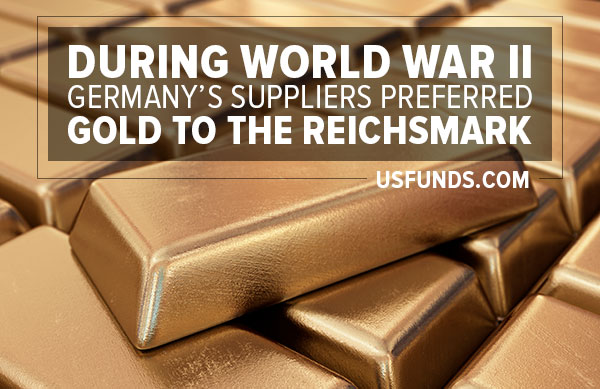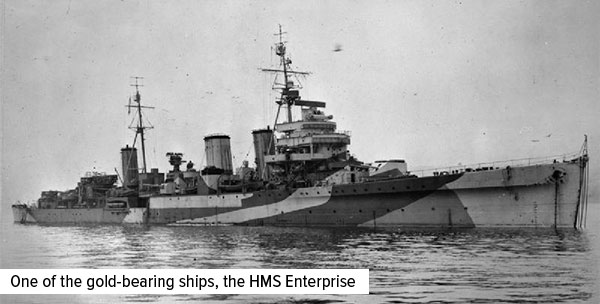by Frank Holmes, CIO, CEO, U.S. Global Investors
I recently had the opportunity to see the excellent 2017 film Darkest Hour, about British Prime Minister Winston Churchill’s struggle to keep the United Kingdom in the fight against the Nazis, even as members of his own government pressured him to capitulate. Gary Oldman’s portrayal of the tough-as-nails leader is at turns tender and rousing—and very well deserving of the Best Actor Oscar.
I’d recommend the film to anyone, whether they’re a student of World War II or not.
It got me thinking, though, about the important role gold played in how the war was financed, as well as the U.K.’s daring efforts to prevent its gold holdings from falling into Adolf Hitler’s hands, should Nazi forces successfully invade the island and ransack its central bank. After all, Germany had done as much in a number of Central European countries before threatening the U.K.
Although not directly addressed in Darkest Hour, the U.K. ended up evacuating billions of dollars’ worth of gold bullion and other assets across the Atlantic, all to be kept safely in Canada. The mission, codenamed “Operation Fish,” is still the largest movement of physical wealth in history.
Germany’s Economic Straits
So why was Hitler so interested in acquiring gold?
To answer that, we really need to go back to the 1920s. At the time, Germany was in serious economic straits. It faced unprecedented hyperinflation, among the very worst such incidents in world history.
This was clearly a problem for Hitler, who, soon after being appointed Reich Chancellor in 1933, set in motion the remilitarization of Germany, in direct violation of the Treaty of Versailles. Because the Western European country is not particularly resource-rich—the one exception is coal—everything from aluminum to zinc would have to be imported to manufacture the guns, tanks, ships, and warplanes needed to wage an extended conflict in the age of advanced machines.
But this was the Great Depression, which had suffocated the German economy as much as it had the United States’. Unemployment climbed to as high as 30 percent. In his inaugural address via radio, Hitler vowed to “achieve the great task of reorganizing our nation’s economy” through “a concerted and all-embarking attack against unemployment.”
Much like Roosevelt’s New Deal in the U.S., Hitler’s government tackled unemployment by dipping into deficit spending. It financed great public works projects such as the autobahn, railroad, housing and more.
The plan worked. Within four years, just as promised, unemployment was virtually thwarted. It’s been said that, had Hitler stopped in 1936 or 1937, he might today be remembered as one of the 20th century’s most admired leaders.
However, Hitler assumed a much more aggressive stance toward national rearmament in an effort to reclaim lost dignity—the Treaty of Versailles be damned. What stood in his way was not only his country’s lack of natural resources but also the fact that many supplier nations would not accept Germany’s worthless currency. They insisted instead to be paid in their own currency; some other international, convertible currency such as Swiss francs or U.S. dollars; or hard currency.
How then would Germany pay for Sweden’s iron ore? Romania’s oil? Turkey’s chromium? Portugal’s tungsten and Spain’s manganese?
Enter gold.
In Gold We Trust
Before we continue, I want to make it clear that Hitler had no respect for the yellow metal, any more than he had for human life. Gold as a currency is built on trust, of which Hitler had none. He hated the metal and all it stands for—but he needed it to push forward his rearmament strategy.

Walther Funk, the Reich’s minister of economics and president of the country’s central Reichsbank, echoed this resentfulness at having to rely on gold:
“As far as currency is concerned, gold is unimportant to us,” Funk said in 1940. “We don’t need it as backing for a currency—which is being managed by price, volume, and wage control—but only to pay clearing balances.”
In other words: We have absolutely no need for gold—until we need it.
But here another problem emerged: Just as it had few natural resources of its own, Germany laid claim to a relatively small gold reserve. In 1933, the Reich’s official holdings stood at only $109 million—not nearly enough to finance the kind of force Hitler envisioned.
The Greatest Gold Heist in History
So began the Reich’s looting of Europe’s gold reserves, beginning with Austria’s in 1938. At the time, Germany’s coffers were nearly empty. The infusion of Austria’s 90 to 100 metric tons of hard currency gave Hitler the boost he needed to continue his plundering.
Today we remember the Nazi’s gold heist as “one of the greatest thefts by a government in history,” in the words of Ambassador and Undersecretary of Commerce Stuart E. Eizenstat, spoken during his 1997 hearing on the status of Holocaust assets. Although estimates vary, and although the gold price fluctuates over time, it’s believed that as much as $600 million—now valued in the billions—were seized from the central banks and vaults of neighboring, occupied countries, including Austria, Poland, Belgium, Holland and the Netherlands. Millions more in silver, platinum, diamonds, artwork and other assets were stolen as well.
Operation Fish
Not every country’s hoard was pilfered, however. Once it was clear what the Nazis were up to, many outlying European countries had the prudence and foresight to secure their own reserves and keep them falling into Hitler’s hands.
And this is where we catch up with the timeline in Darkest Hour. In July 1940, as fears of a Nazi invasion intensified by the day, the U.K. shipped as much as 1,500 metric tons in gold—worth a mind-boggling $160 billion in 2017 dollars—across the Atlantic to be stored in Canada’s central bank in Ottawa.

Codenamed “Operation Fish,” the evacuation was one of the greatest gambles ever. Writes Ottawa-based historian James Powell:
The only way to transport the tons of gold and securities was by ship across the U-boat infested North Atlantic, where 100 Allied and neutral merchant ships had been sunk in May 1940 alone. History was also not reassuring. During World War I, the SS Laurentic, carrying 43 tons of gold from Liverpool to Halifax, had been sunk in 1917 by a German U-boat off of Ireland. The loss of even one treasure ship would have major negative consequences. To buy weapons and other war materiel that it sorely needed from neutral United States, Britain had to pay in gold or U.S. dollars; no credit was permitted under the strict Neutrality Act in effect in the United States at that time.
Britain’s gamble paid off. Every last ingot made it safely across the Atlantic and was prevented from being used by the Nazis to extend their reign of terror a single day longer.
Germany Today a Gold Powerhouse
Although Hitler’s goals were despicable, his absolute need for gold reflects the precious metal’s centuries-long role as a widely accepted and trusted currency.
It’s a lesson Germany hasn’t forgotten, even today.
The country’s official gold holdings stand at 3,372 metric tons, more than any other except the U.S. Gold represents a whopping 70 percent of its foreign reserves—again, second only to the U.S. This has helped Germany become one of the most powerful and stable economies in the world.
More recently, Germany has emerged as the world’s largest gold investor. Although China and India still outpace the European country in total amount of gold consumed, Germans are ploughing more money into gold coins, bars and exchange-traded commodities (ETCs).
All opinions expressed and data provided are subject to change without notice. Some of these opinions may not be appropriate to every investor. By clicking the link(s) above, you will be directed to a third-party website(s). U.S. Global Investors does not endorse all information supplied by this/these website(s) and is not responsible for its/their content.
This post was originally published at Frank Talk.
Copyright © U.S. Global Investors













